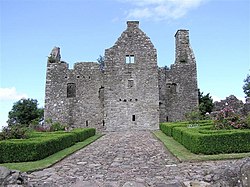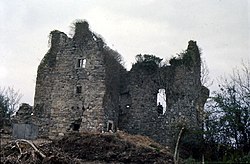Tully Castle
| Tully Castle | |
|
Fermanagh | |
|---|---|
 Tully Castle | |
| Location | |
| Grid reference: | H12675664 |
| Location: | 54°27’29"N, 7°48’22"W |
| Village: | Blaney |
| History | |
| Built 1619 | |
| Information | |
| Owned by: | (State care) |
Tully Castle is a castle in Fermanagh, near the village of Blaney, on Blaney Bay on the southern shore of Lower Lough Erne. The Blaney area takes its name from Sir Edward Blaney, who was among the English advance party sent to Fermanagh to organise the Plantation of the county.
Tully Castle is a fortified house with a rectangular bawn and was built for Sir John Hume, a Scottish planter, in 1619. The bawn had four rectangular corner towers.
History
The castle was built as a residence and fortification during the Plantation of Ulster; built in 1619 by Sir John Hume, to whom this lands hereabouts had been granted.
During the Irish Rebellion of 1641, Rory Maguire set out to recapture his family’s old lands. He arrived at Tully Castle with a large following on Christmas Eve, and found the castle full of women and children. Most of the men were away. Lady Mary Hume surrendered the Castle, believing that she had assured a safe conduct for all in her care, but on Christmas Day the Maguires killed 60 women and children and 15 men, sparing only the Humes. The castle was burnt and the Humes never went back. Captain Patrick Hume later testified about the events of Christmas Day, 1641, saying:
- "And afterwards that same day, the rebels having stripped the Protestants of all their clothes (except the said Lady Hume), they imprisoned them in the vaults or cellars of the said castle, where they kept them with a strong guard all that night, and the next morning, being the Lord’s Day, and the 25th day of December, 1641, they took the Lady Hume, Alexander Hume, John Grier, and this examt., with their wives and children, away from the rest of the prisoners, forth of the said castle, and placed them in the barn of one John Goodfellow at Tully, aforesaid, within a stone’s cast from the castle, putting them in hopes that they meant to convey them to the Castle of Monea, upon horses which they provided for them, but as for the rest that were then left behind in the Castle of Tully, the rebels told those in the barn that they should go on foot after them to Monea aforesaid. But immediately after, upon the 25th of December, 1641, at Tully Castle and within and about the bawn and vaults of the same, in the county of Fermanagh, the rebels did most cruelly and barbarously murder the said Protestants, to the number of men and 60 women and children or thereabouts, the names of the persons so murdered followeth, viz.: Francis Trotter, Thomas Trotter, Alexander Sheringfield, Alexander Bell, George Chearnside, Robert Black, James Barry, Thomas Anderson, Robert Lawdon, John Brooke, David Anderson, James Anderson, and many others - men, women, and children - whose names this deponent doth not now remember. The actors in this massacre, this examt. saith, for the most part are since that time dead, or slain as he heard, and as for such of them as survive, this examt. remembers not their names. And this examt. saith, after the said rebels did pillage and plunder the said castle, they did burn it on the day and year aforesaid. And further this examt. deposeth not anything material." PTK. HUME.
Thereafter, the Hume family seat was replaced nearby with Castle Hume Hall designed by Richard Cassels.
The castle today

Tully Castle and village site are State Care Historic Monuments sited in the townland of Tully.[1]